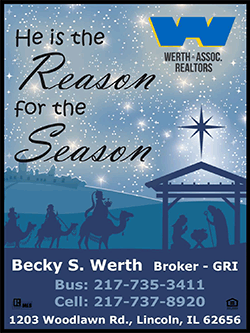|
Santa? I know him!
 Send a link to a friend
Send a link to a friend
[November 30, 2023]
A man of many names, St. Nicholas,
Father Christmas, Kris Kringle, Santa Claus, everyone thinks they
know the story of the rosy cheeked, plump, jolly, cookie loving,
chimney aficionado; but do you really?
|
|
 The
legend begins in sometime around A.D. 280 in Patara, near Myra, what
is now Turkey, with a monk named St. Nicholas. Nicholas was born to
wealthy, Christian parents who died during an epidemic when he was
just a young boy. Admired for his generosity, St. Nicholas has been
the subject of many legends. It has been said that he gave his
entire inheritance to the poor and the sick. The
legend begins in sometime around A.D. 280 in Patara, near Myra, what
is now Turkey, with a monk named St. Nicholas. Nicholas was born to
wealthy, Christian parents who died during an epidemic when he was
just a young boy. Admired for his generosity, St. Nicholas has been
the subject of many legends. It has been said that he gave his
entire inheritance to the poor and the sick.
From Bishop of Myra to Gift Giver
Nicholas was made Bishop of Myra while he was still a young man. He
showed his devotion to God by extraordinary kindness and generosity
to those in need. Nicholas was a defender of the church during the
Great Persecution in 303, when bibles were burned, and priests were
made to denounce Christianity or face death.
By around 1200, Nicholas became known as the patron of children and
a magical gift giver because of two legends. One account claims that
St. Nicholas presented three poverty stricken young women with
dowries so that they would not have to resort to the way of the
streets. On three separate occasions bags of gold were thrown
through the windows of the ladies and landed in stockings or shoes
left by the fire to dry. This led to the custom of leaving stockings
or putting out shoes for St. Nicholas to fill. Over the years,
Nicholas’ popularity spread, he became known as the protector of
children and sailors. The day of his death, December 6, is
celebrated with a feast. It was the custom for parents to secretly
leave little gifts for their children who were taught to believe
they were from St. Nicholas.

St. Nicholas comes to the New World
The first Europeans to arrive in the New World brought St. Nicholas.
December 6, 1492, Colombus named a Haitian port for St. Nicholas.
Spaniards named what is now the St. Nicholas neighborhood in
Jacksonville, Florida Nicholas Ferry. The 16th century Protestant
Reformation all but eliminated talk of the saints, but the
traditions of St. Nicholas survived. The St. Nicholas customs moved
beyond church into popular culture. It was also in this era that St.
Nicholas’ mode of entry changed from windows to chimneys.
Sinter Klaas in New York
The name Santa Claus is derived from St. Nicholas’ Dutch Nickname,
Sinter Klaas. In December of 1773 a New York Newspaper reported that
Dutch families were gathering to honor St. Nicholas on December 6,
the anniversary of his death. Over time the stories of St. Nicholas
became less popular and gift giving in December became problematic.
Parents wanted to still secretly give their children gifts, but in
whose name? That job soon fell to Baby Jesus and what we now know as
Christmas was changed from being celebrated on December 6th to
December 25th.
Santa Claus is Coming to Town
The New York Historical Society held it’s first St. Nicholas
anniversary dinner in 1810. An artist was commissioned to create the
first American image of Nicholas for the occasion. He was depicted
giving gifts and placing treats in stockings hung by a fireplace.
The 19th Century was a turning point for what we now know as Santa
Claus. Many New York writers and artists wanted to Americanize the
holiday. Santa Claus, The Children’s Friend, written in 1821 was the
first-time images of Santa Claus were not of a saintly robed bishop
to a jolly man from the North flying in a sleigh with reindeer. In
1824 Clement Clarke Moore wrote the poem “A visit from St.
Nicholas.” This poem is now better known as “The Night Before
Christmas”. Santa Claus was described as dressed all in fur, with
twinkling eyes, cheeks like roses, a nose like a cherry, a white
beard, and a plump belly.
Santa at the shopping mall
The first life-size Santa model was in a Philadelphia store in 1841.
Stores all around the United States began to advertise visits with
real live Santas. In the early 1890’s the Salvation Army needed to
raise money to pay for the Christmas meals they provided for needy
families. They began dressing unemployed men in Santa Claus suits
and sending them into the streets of New York to solicit donations.
Those same Salvation Army Santas have been ringing bells on corners
and in stores around American cities ever since.
[to top of second column] |

The Macy’s Santa first appeared in the Thanksgiving
Day Parade in 1924 and has been featured in nearly every one since.
That year also marked the first time Macy’s in New York featured the
shopping mall Santa as we know him today. Children could sit on his
lap, get a picture, and tell him what they want for Christmas.
Children of all ages still line up to meet Santa at the New York
Macy’s store and other stores around the country. “Miracle on 34th
Street,” a 1947 motion picture, features perhaps the most iconic
department store Santa. A young Natalie Wood plays a girl who
believes Kris Kringle when he says he is the “real” Santa Claus.

St. Nicholas and Santa Claus
How do they differ? Santa Claus belongs to childhood and St.
Nicholas sets an example of how you should behave your whole life.
Santa Claus represents commerce and gifts and St. Nicholas
represents the story of Christ and goodwill.
Santa Claus appears once a year and St. Nicholas is always
surrounding us with his example of generosity.
Santa Claus comes from the North Pole with flying reindeer while St.
Nicholas walked the earth caring for the needy.
Modernization of Santa Claus seemed to replace the idea of
celebrating the Babe of Bethlehem and St, Nicholas points to God by
reminding us to be kind and generous.
So now, when your children ask you if Santa Claus is real you can
tell them the truth. Yes! Santa Claus is indeed real. The Santa
Claus you see in stores, books, and movies is a person in a costume.
People dress up as Santa Claus to remind us of a real person that
lived long ago named St. Nicholas who secretly gave money and gifts
to the poor.
The magic of Christmas is alive, as long as you believe.
[Lesleigh Bennett]
References:
https://www.history.com/
topics/christmas/santa-claus
https://www.nationalgeographic.
com/history/article/13219/santa-
claus-origin-history-christmas-facts-
st-nicholas/
https://www.stnicholascenter.org/
|
Read all the articles in our
new
2023 Home for the Holiday magazine
|
 |